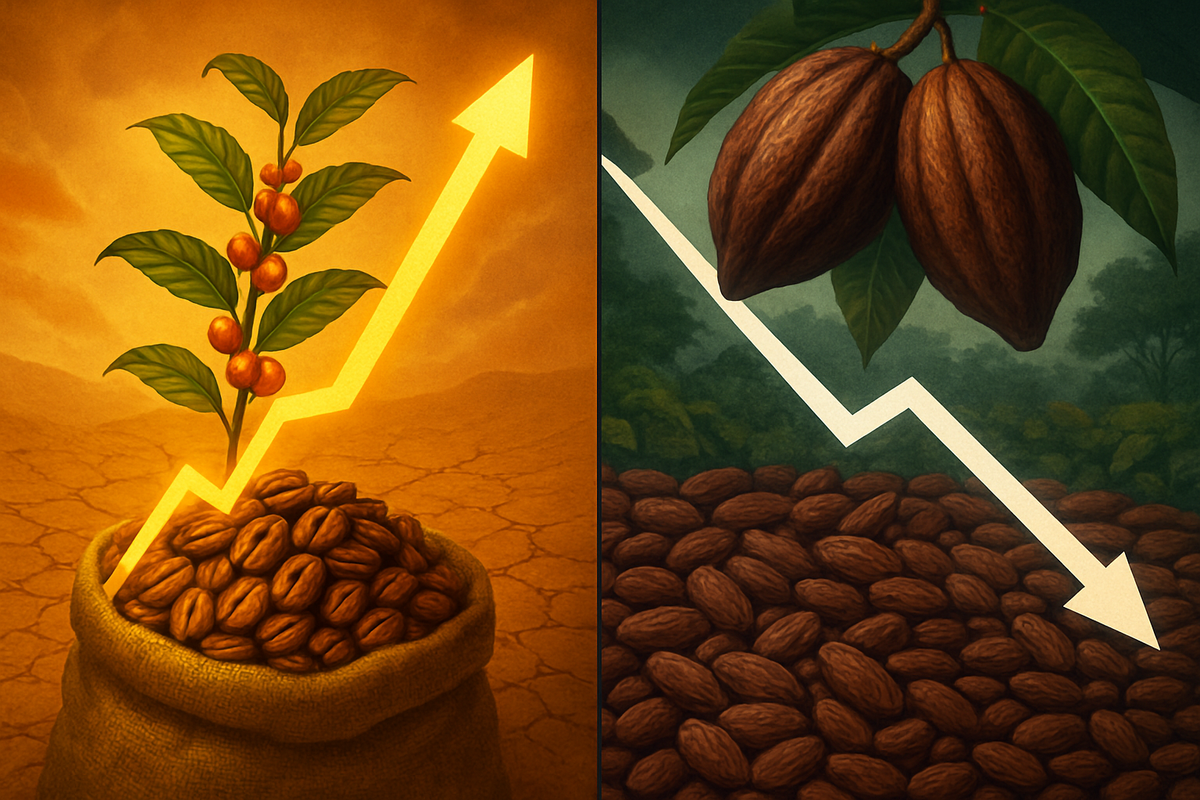
The global commodity markets are currently telling a starkly different story for two of the world's most beloved beans: coffee and cocoa. As of October 2025, coffee prices are experiencing an unprecedented surge, reaching multi-year highs driven by acute supply shortages and relentless demand. In stark contrast, cocoa, after a period of historic price peaks, is now undergoing a significant downturn, with prices plummeting as supply prospects improve and consumer demand wanes. This dramatic divergence highlights distinct market dynamics at play, creating a complex landscape for producers, manufacturers, and consumers worldwide.
The immediate implications of these opposing trends are profound. Coffee lovers are already facing significantly higher prices for their daily brew, with U.S. coffee prices hitting 25-year highs, forcing shifts in consumption habits. For coffee roasters and retailers, the escalating bean costs and new tariffs are squeezing margins, prompting price increases and a desperate search for supply chain resilience. Conversely, while cocoa prices fall, chocolate manufacturers are still grappling with reduced demand and the need to process expensive cocoa secured during previous price surges, meaning relief for consumers at the checkout is unlikely to be immediate.
Unpacking the Price Paradox: Supply Shocks vs. Demand Destruction
The narrative for coffee prices over the past year has been one of relentless ascent, fueled by a "perfect storm" of adverse conditions. Arabica coffee futures, the global benchmark, soared to an astounding $4.24 per pound on September 16, 2025, while Robusta prices reached near five-decade highs. Despite minor fluctuations, coffee prices remain a staggering 54.61% higher than a year ago, with Arabica more than doubling in the past twelve months. This surge is primarily attributed to a dramatic decline in Intercontinental Exchange (ICE) monitored inventories, with Arabica stocks falling to a 1.5-year low and Robusta inventories hitting a 2.5-month low by early October 2025, signaling a severe tightening of readily available supply.
A series of devastating weather events has been central to this supply crisis. A severe frost in Brazil in 2021 initially set the stage, followed by persistent droughts, heatwaves, and further frosts in Brazil throughout 2023-2024. Vietnam, the world's top Robusta producer, also suffered from a combination of drought and heavy rainfall, leading to an estimated 20% decline in its 2023/24 crop. Brazil's 2025 Arabica production is projected to decline by a further 12.4%. Adding to these woes, new trade policies, including a 10% U.S. tariff on most coffee imports in April 2025 and a steep 50% tariff on Brazilian coffee in late July 2025, further exacerbated supply chain disruptions and inflated U.S. prices. Coupled with strong global demand, particularly from emerging markets like China and India, and rising operational costs due to supply chain bottlenecks and geopolitical tensions, speculative trading has further amplified market volatility, pushing prices to unprecedented levels.
In stark contrast, cocoa prices, after reaching historic all-time highs of $12,906 per ton in December 2024 and $10.75/kg in early 2025, are now experiencing a sharp and sustained decline. New York cocoa futures have fallen to $6,150 per ton, with London futures at £4,262 ($5,713) per ton, representing a dramatic 58% drop from their April 2025 peaks. Prices have plummeted over 10% in the first week of October alone, reverting to early 2024 levels. This reversal is largely driven by an improved supply outlook for the upcoming 2025/26 season and a significant weakening of global demand.
Forecasts for the 2025/26 season indicate a potential recovery in production, with Ghana's cocoa output expected to strengthen due to favorable weather. The harvest of Ivory Coast's main crop has just begun, with farmers expressing optimism about its quality, and recent cocoa pod counts in West Africa are reportedly 7% above the five-year average. The International Cocoa Organization (ICCO) has even projected a global cocoa surplus of 142,000 metric tons for the 2024/25 season—the first surplus in four years—and anticipates a 7.8% year-on-year rise in global production. This improved supply picture coincides with a notable decline in demand, as previously high cocoa prices led to "demand destruction." Cocoa grindings, a key measure of demand, saw significant declines in Q2 2025 across Europe (-7.2%), Asia (-16.3%), and North America (-2.8%), indicating that manufacturers are struggling with higher costs and reduced consumer interest in premium chocolate products.
Corporate Fortunes: Who Wins and Who Loses?
The diverging price trends for coffee and cocoa are creating clear winners and losers across the global agricultural and food sectors. For coffee producers in regions with robust harvests, such as Colombia, which saw a record crop in 2024/25, the elevated prices translate into significantly higher revenues. However, the benefits are not uniform, as many producers in Brazil and Vietnam continue to grapple with climate-induced yield reductions. The long-term challenge for all coffee growers remains adapting to climate change and managing rising operational costs, even with current high prices.
On the other side of the bean, coffee roasters and retailers are facing immense pressure. Major players like Keurig Dr Pepper (NASDAQ: KDP) and Starbucks (NASDAQ: SBUX) are directly impacted by the soaring bean costs and new U.S. tariffs. They are being forced to implement price increases for consumers, which could dampen demand, and are anticipating lower gross profit margins. These companies are actively seeking to diversify supply channels, employ sophisticated hedging strategies, and invest in supply chain resilience to mitigate extreme volatility. Smaller, independent coffee shops are particularly vulnerable, with some already struggling to absorb the increased costs and facing closure.
For cocoa producers, the recent decline in prices presents a mixed bag. While the previous record highs were a boon, the current downturn could lead to lower incomes for farmers. However, governments in Ivory Coast and Ghana have recently boosted farmgate prices, a move designed to encourage sales and ensure a more stable income for growers, which could partially offset the impact of falling global prices. This government intervention is crucial for maintaining farmer livelihoods and incentivizing continued production.
Chocolate manufacturers, such as Barry Callebaut (SIX: BARN) and Lindt & Sprüngli (SIX: LISN), find themselves in a complex situation. While the improved supply outlook for 2025/26 is a positive sign for future sourcing, they are currently grappling with the aftermath of historically high cocoa prices. Many manufacturers purchased cocoa at peak prices, and it will take time for this expensive inventory to work through their systems. Coupled with reduced consumer demand for chocolate products due to previous price hikes, companies like Barry Callebaut have already reduced their sales volume guidance, indicating ongoing profitability challenges. The industry is in a delicate balancing act, trying to regain consumer interest while managing input costs and navigating a market that has seen significant "demand destruction."
Wider Significance: A Glimpse into Global Commodity Volatility
The diverging fortunes of cocoa and coffee prices are not isolated incidents but rather symptomatic of broader trends in global commodity markets, particularly the increasing impact of climate change and geopolitical factors on agricultural supply chains. The coffee crisis underscores the vulnerability of monoculture farming and reliance on specific regions, highlighting the urgent need for diversification and the development of climate-resilient crop varieties. It also emphasizes how rapidly adverse weather events can cascade into global supply shocks, challenging the stability of essential food and beverage items.
The situation also reveals the powerful ripple effects across industries. For coffee, the sustained high prices could accelerate innovation in alternative beverages or encourage consumers to shift towards cheaper coffee varieties or at-home brewing. For cocoa, the "demand destruction" caused by previous price peaks serves as a cautionary tale for any commodity, illustrating how sustained high prices can fundamentally alter consumer behavior and industry profitability. Competitors in the broader snack and beverage markets may see shifts in consumer preferences as people seek more affordable indulgences.
Regulatory and policy implications are also evident. The U.S. tariffs on coffee imports, for instance, demonstrate how trade policies can dramatically impact commodity flows and prices, creating additional burdens for importers and consumers. In the cocoa sector, the intervention by Ivorian and Ghanaian governments to boost farmgate prices reflects a growing recognition of the need to support farmers' livelihoods and ensure sustainable production, even as global prices fluctuate. Historically, agricultural commodity markets have always been susceptible to weather patterns and geopolitical events, but the intensity and frequency of these disruptions appear to be escalating, making historical precedents less reliable for future forecasting. This current scenario points to a future where supply chain resilience and strategic sourcing will become paramount for companies dealing with agricultural commodities.
What Comes Next: Navigating an Uncertain Future
Looking ahead, the short-term outlook for coffee suggests continued volatility and elevated prices. While hopes of eased trade tensions might offer temporary dips, the underlying supply shortages, particularly the low ICE inventories, are likely to keep prices high well into 2026. The potential threat of a La Niña weather system from October to December 2025 could bring dry conditions to Brazil, potentially harming the 2026/27 crop and leading to further price increases. Coffee companies will need to continue their strategic pivots, focusing on securing long-term supply contracts, exploring new growing regions, and investing in sustainable and climate-resilient farming practices. Consumers should brace for sustained high prices for their favorite brews.
For cocoa, the immediate future appears to offer some relief on the supply side, with improved forecasts for the 2025/26 season. However, the market faces the challenge of rebuilding demand after a period of significant "demand destruction." Chocolate manufacturers will need to carefully manage their pricing strategies to entice consumers back while slowly working through higher-cost inventory. The long-term picture for cocoa remains complex, overshadowed by structural challenges in West Africa, including aging plantations, the persistent Cacao Swollen Shoot Virus (CSSV), low farmer incomes, and the impact of illegal gold mining. These issues could limit production and exports in the long run, potentially leading to future price volatility once current surpluses are absorbed. Strategic adaptations will involve continued investment in farmer support programs, disease-resistant varieties, and sustainable sourcing initiatives to ensure a stable future supply.
Market opportunities may emerge for companies that can innovate with alternative ingredients or develop more efficient processing methods to manage costs. For investors, the commodity markets will present both challenges and opportunities. Those with exposure to coffee futures or coffee-related stocks may see continued gains, albeit with increased risk due to volatility. Conversely, the cocoa market could see further price adjustments as it seeks a new equilibrium between recovering supply and re-establishing demand. The emphasis for all stakeholders will be on adaptability, resilience, and a deep understanding of the evolving climate and geopolitical landscape.
A Bitter-Sweet Conclusion: Enduring Volatility and Strategic Shifts
The current divergence in cocoa and coffee prices serves as a potent reminder of the inherent volatility and interconnectedness of global commodity markets. For coffee, the key takeaway is the profound impact of climate change and trade policies on agricultural supply, leading to sustained price surges and significant challenges for the entire value chain, from farmers to consumers. The market is clearly signaling a need for systemic changes in how coffee is produced, sourced, and consumed.
For cocoa, the narrative is one of market correction after unprecedented highs, driven by an improved supply outlook and a clear instance of "demand destruction." While the immediate future offers some respite from soaring prices, the underlying structural issues in major producing regions mean that long-term stability is far from guaranteed. Manufacturers face the delicate task of balancing input costs with consumer demand, while farmers' livelihoods remain a critical concern.
Moving forward, investors should closely watch weather patterns in key producing regions, particularly for coffee, as well as any shifts in trade policies. For cocoa, monitoring grind data and overall consumer sentiment towards chocolate will be crucial indicators. The ability of companies to adapt their supply chains, manage costs, and innovate will be key determinants of success in these turbulent markets. Ultimately, the tale of these two beans underscores the increasing fragility of our global food systems and the imperative for resilience, sustainability, and strategic foresight in the face of evolving environmental and economic pressures.
This content is intended for informational purposes only and is not financial advice





